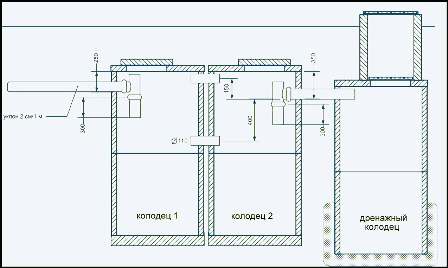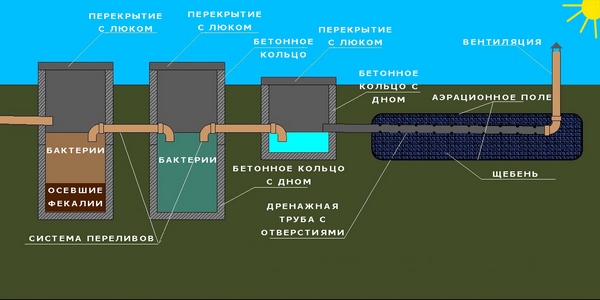The sewage system made of concrete rings is one of the most popular among those that can be done on the site with your own hands. However, in order for it to work with maximum efficiency, it is important not to make mistakes at the main stages:
- determination of the required volume,
- choice of design,
- choice of installation site,
- installation of the sewerage system and communications.
Sewerage for a private house made of concrete rings has undeniable advantages:
- durability of the structure,
- mechanical strength and rigidity,
- relatively low cost of material,
- resistance of concrete to corrosive processes under the influence of moisture and chemically active substances,
- fast assembly.
When choosing, you should take into account the disadvantages:
- Concrete has good hygroscopicity, therefore tank walls need waterproofing... Otherwise, untreated water will partially seep into the ground.
- Due to the large mass of the rings for installation it is necessary to use special equipment, which will require additional costs.
Installation and its nuances
The features of the material are directly related to some of the nuances of installation that are characteristic of all types of sewage systems in this category, regardless of the chosen design.

What characteristics have you read in a separate article. There you can find information about their types, sizes and prices.
About vacuum pumps for sewage is possible. The types and main characteristics of the units are described.
The principle of operation of various designs
Depending on the conditions in which sewage from concrete rings is used, the scheme is selected optimally suitable for them.
- Single chamber models often chosen for summer cottages or country houses with seasonal living. They require periodic cleaning with a waste disposal machine.
- The frequency of pumping out two-chamber structures much less. Such options are often considered universal. With the right choice of volume and proper installation, they provide a sufficiently high degree of cleaning, while such models require less space on the site than three-chamber ones, it is easier for them to find a place that meets all sanitary requirements.
- Three-chamber the country sewage system made of concrete rings is also suitable for private houses with permanent residence, as well as for summer cottages, which, in addition to a washbasin and a toilet, have a shower, a full bathroom, and a washing machine. A system of this type is capable of providing high quality cleaning with mixed (organic substances and chemical components, including detergents) contamination. Among septic tanks with three chambers, a distinction is made between volatile (in them the drains are purified due to the vital activity of aerobic bacteria) and non-volatile. The former are distinguished by a shorter processing cycle and efficiency, the latter by the absence of operating costs.

Calculation of the volume of sewage and standard sizes of rings
The total volume of the treatment plant depends on the average daily water consumption of all residents of the house. It, in turn, can be calculated by points of consumption (shower, washbasin, etc.), but it is much easier to use the accepted value - 200 liters per day for each person.
The water purification cycle is approximately three days, during which the wastewater must be collected in the sewer system. Thus, for a family of three, the required volume is calculated as follows:
3 (people) x 200 (liters) x 3 (days) = 1800 liters (or 1.8 cubic meters).
- When choosing a single-chamber model, the entire volume falls on a single container.
- In a two-chamber design, the storage tank is 3/4 of the total volume, and 1/4 is in the second chamber.
- In a three-chamber septic tank, the storage is 2/3 of the volume, and 1/3 falls on the second and third chambers in total (most often they have the same size).
Many owners use only one ring size for all sewer tanks.
During installation, three concrete rings are usually stacked on top of each other. A smaller amount is impractical due to insufficient capacity, a larger one can reduce the reliability of the structure.
Since standard concrete rings have the same height - 900 mm, the volume is determined by their diameter. Many enterprises offer the manufacture of concrete products with any parameters to order, however, such rings will cost more and will increase the total cost of the structure. It is permissible to use rings with an inner diameter from 700 to 2000 mm for the device of tanks, however, in most cases, preference is given to the two most common standard sizes: KTs-10 (KS-10) and KTs-20 (KS-20). The numbers in the marking indicate the size of the inner diameter in decimeters.
Sewerage scheme elements
A septic tank or treatment facility is the main structural element, but this is far from the entire sewage system made of concrete rings - the scheme includes other elements that should be discussed separately.
Sewer pipes supplying drains to the storage tank should have a slope of 2 cm per meter, if the liquid is transported by gravity, without using a pump.

SNiP strictly regulates the installation of inspection wells along the entire length of the pipeline:
- at the junction of the lines,
- when changing parameters (slope of communications or their diameter),
- when turning the pipeline.
For straight-line communications, the distance between manholes is determined by the diameter of the pipeline:
- up to 150 mm - 35 meters,
- 200 mm - 50 meters.
In summer cottages, the sewerage system is installed not too far from the house, so the number of wells is rarely more than 1-2.
For volatile modifications, a ventilation pipe is required, as well as a compressor for air injection, which is better to choose with the ability to regulate the capacity and with a timer.
In the sewage system at the dacha, made of concrete rings for effective drainage of purified water, the bottom filter is not suitable in all cases. Dense soils (clay and loam) do not have good water permeability, which reduces the rate of drainage. As an auxiliary device, perforated pipes can be used, which come out of the bottom of the chamber with purified water (the second or third, depending on the design) have plugs at the ends and are located parallel to the surface of the earth at a shallow depth. Such devices increase the drainage area.

In the case of a very high clay content in the soil, it is preferable to have a drain pump that will transport the treated water to a drainage ditch or to an irrigation tank. In the second case, the quality of the water requires testing in the laboratory.
Another option for arranging the sewage system on the site is. You can find out how to do it from another article.
For those who are going to build an outdoor toilet, our article may be interesting. This option is environmentally friendly and simple device.
We told how to conduct a water supply system from a well.
Septic tank placement
It may seem that in order to ensure the slope of the sewer pipeline, it is easier to install concrete rings for the sewer in the lowland, however, in this case, rain and melt water will get into the tank, overflowing it.
Reservoirs must be installed no closer than 5 meters from a residential building, and also maintain a distance to sources of drinking water (30-50 meters) and 30 meters to open water bodies.
Installation of concrete rings for sewerage video
How to make a sewer from concrete rings is demonstrated in the video.



